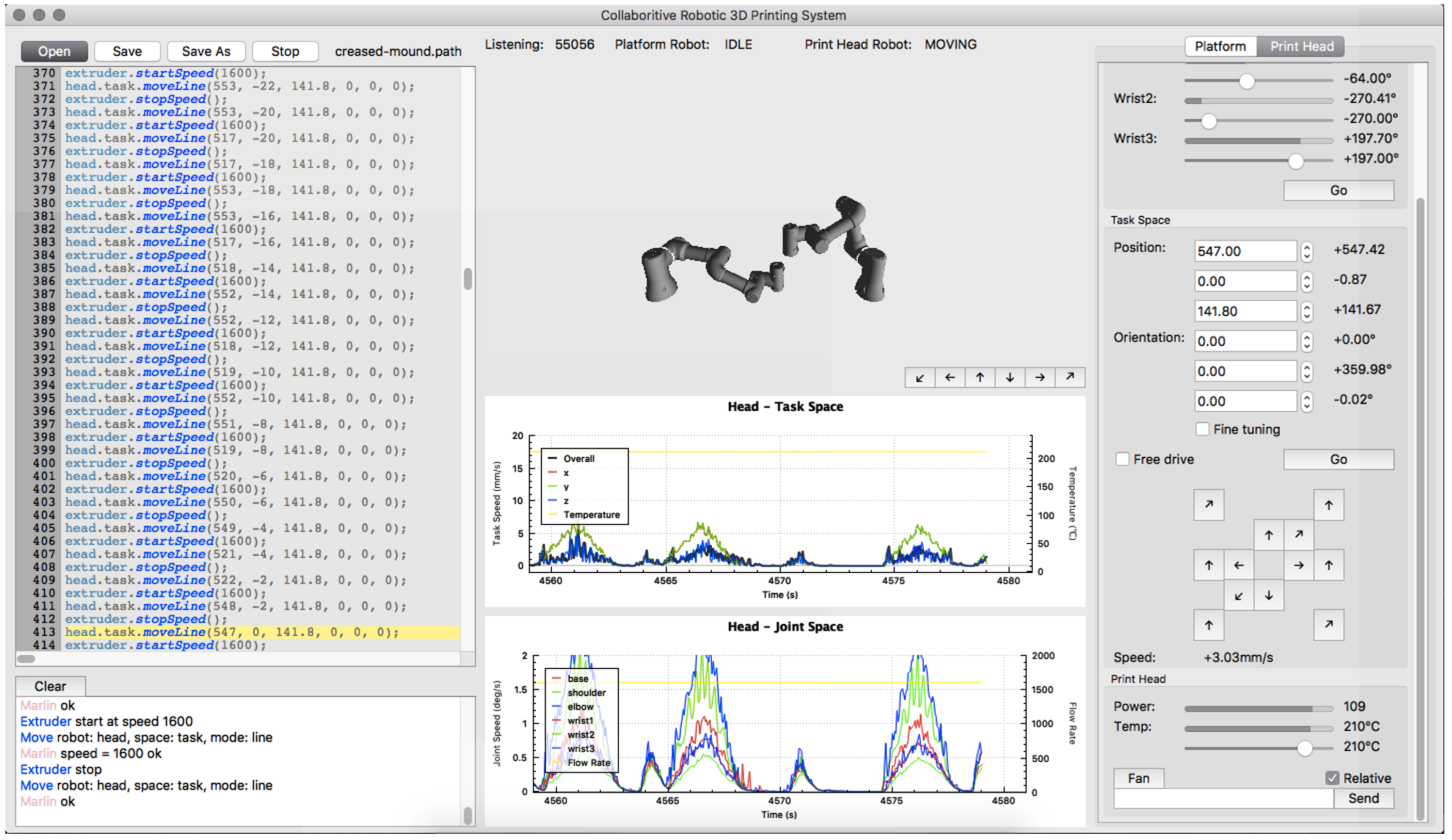Projects
Login
Login
Error
Email
Password
Login
Project Information
Thesis
System design, implementation, thesis
2/2017 - 11/2017
Robotic, FDM 3D Printing, C++, Qt, Arduino, OpenGL
Collaborative Robotic 3D Printing
New techniques to improve the efficiency and cost-effectiveness of 3D printing. This research demonstrates the strength of using two robotic arms collaboratively.
Collaborative Robotic 3D Printing
New techniques to improve the efficiency and cost-effectiveness of 3D printing. This research demonstrates the strength of using two robotic arms collaboratively.
Project Information
Thesis
System design, implementation, thesis
2/2017 - 11/2017
Robotic, FDM 3D Printing, C++, Qt, Arduino, OpenGL
# Introduction 3D printing is commonly used for rapid prototyping, allowing designers to generate and test components within a short timeframe. However, one of the most commonly used techniques prints layer-by-layer as the filament can only be printed on existing material rather than in empty space. This means additional scaffold structures are required to print complex features (such as overhangs), which must then be manually removed after printing. This is both time-consuming and wasteful. In order to address the drawbacks of this traditional method a robotic 3D printing system was designed and implemented. Using two UR-3 robotic arms a more efficient system was developed. In this new system one arm rotates a build platform while the other prints material. This allows filament deposition to work with gravity, eliminating dangling and sagging of the extruded material in many cases. This research demonstrates the strength of using two robotic arms collaboratively. Using the developed technique freeform shapes and wireframe printings were produced without the need for support structures, saving time and material. <div class="ui embed" data-source="youtube" data-id="YDovJMZNWHw" data-placeholder="/uploads/4f99d749-82d8-4bc1-b515-f592ef58e2c8"> </div> # Software Architecture  The software of this system consists of three main components, which are: (1) a robot controller running on the UR robots; (2) a 3D printing controller on the RAMBo board; (3) and a central controller on a computer. URScript is a programming language developed by Universal Robots running on a robot controller connected to a UR robotic arm. By writing a URScript, we can control the movement of a robotic arm and perform simple calculations such as basic arithmetic and trigonometric functions. URScript also supports socket programming which enable us to exchange information between the robot and the central controller. 1. Robot Controller URScript consists of four major components. The network layer is used to send and receive data from the central controller so that it can be controlled and report its status. The command processor processes messages coming from the network layer. 2. 3D Printing Controller To achieve support-free 3D printing, the 3D printer firmware was modified. The firmware we use is Marlin. It is an open source 3D printer firmware which allows full control of the printing process. It is easy to be modified so that it can adapt our robotic 3D printing. The central controller is responsible for printing script editing, robotic arm simulation and debugging, path computation, robotic arms and 3D printing system controlling. 3. Printing IDE (Central Controller) The central controller is responsible for printing script editing, robotic arm simulation and debugging, path computation, robotic arms and 3D printing system controlling.  # Results To show this novel 3D printing system is superior to the conventional 3D printing system in terms of saving material and print time, three representative models are printed using both our system and a traditional FDM 3D printer. 1. Support-Free Layer-Based 3D Printing The following picture shows the first test we printed for support-free layer-based printing, a curved pipe. It is also designed using the generalised cylinder approach and printed with platform rotation after each layer. The result is smooth, consistent and seamlessly.  Design and the print result of curved pipe. 2. Wireframe Printing The second model we have compared is the wireframe cube. We have presented a novel wireframe 3D printing technique that all edges in the air are printed vertically to the ground by rotating the build plate. It shows our approach can print wireframe edges at 100 mm without sag. Because of the special geometric features it has, our approach can save as much as 82% material which is used as support structure in the one printed by Ultimaker 3. In addition, the one made by Ultimaker 3 is not as smooth as our print.  3. Freeform 3D Printing The third model is the candle holder which has a huge amount of overhangs, requiring a lot of support structure to be printed on a conventional 3D printer. It is extremely unlikely that these supports would be able to be removed without damaging the printed model. This comparison also shows our system is superior to conventional FDM when printing overhanging geometry.  Comparison between candle holders printed by Ultimaker 3 (left) and our approach (right). # Project members * Yingchen Liu * Jon McCormack * Elliott Wilson # Related information Web page on the SensiLab website: [https://sensilab.monash.edu/research/robotic-3d-printing/](https://sensilab.monash.edu/research/robotic-3d-printing/ "https://sensilab.monash.edu/research/robotic-3d-printing/")